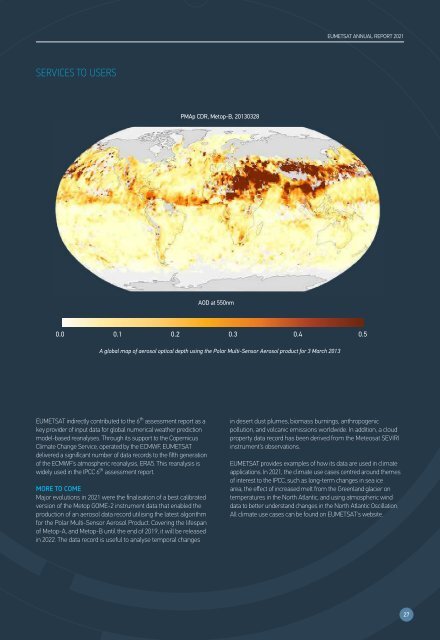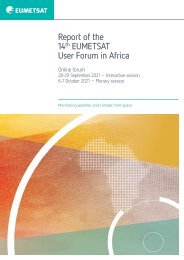EUMETSAT Annual Report 2021
Create successful ePaper yourself
Turn your PDF publications into a flip-book with our unique Google optimized e-Paper software.
<strong>EUMETSAT</strong> ANNUAL REPORT <strong>2021</strong><br />
SERVICES TO USERS<br />
PMAp CDR, Metop-B, 20130328<br />
AOD at 550nm<br />
0.0<br />
0.1 0.2 0.3<br />
0.4 0.5<br />
A global map of aerosol optical depth using the Polar Multi-Sensor Aerosol product for 3 March 2013<br />
<strong>EUMETSAT</strong> indirectly contributed to the 6 th assessment report as a<br />
key provider of input data for global numerical weather prediction<br />
model-based reanalyses. Through its support to the Copernicus<br />
Climate Change Service, operated by the ECMWF, <strong>EUMETSAT</strong><br />
delivered a significant number of data records to the fifth generation<br />
of the ECMWF’s atmospheric reanalysis, ERA5. This reanalysis is<br />
widely used in the IPCC 6 th assessment report.<br />
MORE TO COME<br />
Major evolutions in <strong>2021</strong> were the finalisation of a best calibrated<br />
version of the Metop GOME-2 instrument data that enabled the<br />
production of an aerosol data record utilising the latest algorithm<br />
for the Polar Multi-Sensor Aerosol Product. Covering the lifespan<br />
of Metop-A, and Metop-B until the end of 2019, it will be released<br />
in 2022. The data record is useful to analyse temporal changes<br />
in desert dust plumes, biomass burnings, anthropogenic<br />
pollution, and volcanic emissions worldwide. In addition, a cloud<br />
property data record has been derived from the Meteosat SEVIRI<br />
instrument’s observations.<br />
<strong>EUMETSAT</strong> provides examples of how its data are used in climate<br />
applications. In <strong>2021</strong>, the climate use cases centred around themes<br />
of interest to the IPCC, such as long-term changes in sea ice<br />
area, the effect of increased melt from the Greenland glacier on<br />
temperatures in the North Atlantic, and using atmospheric wind<br />
data to better understand changes in the North Atlantic Oscillation.<br />
All climate use cases can be found on <strong>EUMETSAT</strong>'s website.<br />
27









